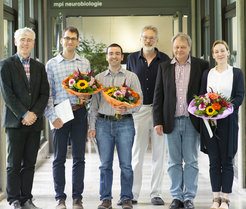Award for outstanding publications
Susanne Falkner and co-first authors Daniel del Toro & Tobias Ruff receive „Young Scientist Award“

Publishing the own scientific results, often after years of research, is a big moment for every scientist. Especially, since the 17th century only results published in a scientific journal are accepted as scientific valid. By publishing, other scientists worldwide can review the results and may use this knowledge e.g. for advanced studies.
In recognition of outstanding publications, the Max Planck Institute of Neurobiology awards the “Young Scientist Award” to young researchers from the institute. For the year 2017, the award, which comes with a prize money of 1.000 Euros, goes to Susanne Falkner and the co-first authors Daniel del Toro and Tobias Ruff.
The outstanding publications
Susanne Falkner
New neurons for the brain
Transplanted embryonic nerve cells can functionally integrate into damaged neural networks
When it comes to recovering from insult, the adult human brain has very little ability to compensate for nerve-cell loss. Biomedical researchers and clinicians are therefore exploring the possibility of using transplanted nerve cells to replace neurons that have been irreparably damaged as a result of trauma or disease. However, it is not clear whether transplanted neurons can be integrated sufficiently, to result in restored function of the lesioned network. Now researchers at the Max Planck Institute of Neurobiology in Martinsried, the Ludwig Maximilians University Munich and the Helmholtz Zentrum München have demonstrated that, in mice, transplanted embryonic nerve cells can indeed be incorporated into an existing network and correctly carry out the tasks of damaged cells originally found in that region. (Nature, October 2016)
Susanne Falkner studied Molecular Biology at the University of Vienna. She did the research for her PhD thesis in the department Synapses – Circuits – Plasticity of Tobias Bonhoeffer at the Max Planck Institute of Neurobiology. Now she works as a postdoc at the University of Basel since 2017. In Basel, she works at the Center for Molecular Life Sciences in the group of Peter Scheiffele.
Daniel del Toro and Tobias Ruff
The formation of folds on the surface of the brain
Adhesion of migrating neurons influences the folding of the cerebral cortex
Folds in the human brain enlarge the surface of this important processing organ and in this way create more space for higher functions including thought and action. However, certain species of mammals exist whose brains have smooth surfaces, for example mice. Scientists from the Max Planck Institute of Neurobiology in Martinsried have discovered a previously unknown mechanism for brain folding. Young neurons, which migrate to the cortex during the development of a smooth-surfaced brain, have so-called FLRT receptors on their cell surface. These ensure a certain degree of adhesion between the cells and regular migratory behavior, which favors the formation of a smooth brain surface. Compared to the mouse brain, in the human brain FLRTs are much less abundant. If the expression of FLRTs in the mouse brain is reduced experimentally, folds similar to those found in the human brain form. These findings provide new insights into the evolution of smooth and folded mammalian brains. (Cell, May 2017)
Daniel del Toro studied Biology at the University Pompeu Fabra in Barcelona (Spain) and gained his PhD at the University of Barcelona. He joined as postdoc the department Molecules - Signaling – Development of Rüdiger Klein at the Max Planck Institute of Neurobiology in 2010.
Tobias Ruff studied Chemistry, Biochemistry and Neurobiology at the Ludwig Maximillians University in Munich where he also gained his Masters. He came as a Master student to the department Molecules – Signaling – Development, led by Rüdiger Klein at the Max Planck Institute of Neurobiology in 2014, where he continues to work on his PhD project.












